
Logan and Albert Conservation Association

 Ipswich Koala Protection Society is one of the key groups that have formed an alliance to fight the nexus between developer donations and political decisions.
Ipswich Koala Protection Society is one of the key groups that have formed an alliance to fight the nexus between developer donations and political decisions.
"We're tired of writing submissions and 'comments' that seem to be ignored," said Helen Darbellay, IKPS Secretary, "they have not provided any protection to Ipswich koalas in the past and are not likely to in the future unless serious changes are made to stop landclearing and protect essential regrowth" she said.
"About six years ago we, (IKPS) worked with Ipswich City Council planners to identify and map key areas of koala habitat only to have much of it 'unmapped' by the state government" Ms Darbellay said.
"The comparison between koala observations in Ipswich and the latest GHD koala habitat mapping show little recognition of large areas of high density and important lower density koala landscapes throughout Ipswich, with Ipswich being shown as largely white space on the GHD map," she said.
"The Regional Plan maps and Infrastructure plans threaten core areas and koala corridors. The proposed Southern Freight Rail Corridor threatens large tracts of prime habitat, known to be home to a large population of healthy koalas. The area is an undocumented Biodiversity hotspot, yet is afforded no protection under any local, State or Federal legislation.
"The koala as an umbrella species and fauna icon should be declared Endangered"
Please browse the pages of the IKPS's website to learn more about their activities. Based in South-East Queensland, IKPS is an incorporated group that provides a 24/7 ambulance service for more than 100 sick, injured or orphaned koalas each year. IKPS helps to raise baby koalas orphaned by motor vehicles and domestic dog attacks. IKPS plants trees that provide koalas food to replace those lost as a result of development.
IKPS provides information to the community and to local government on koalas, their needs and their future. IKPS has no paid staff ... everyone is a volunteer. And you can help too!
Any assistance you can offer will be greatly appreciated.
Koalas to lose ‘prime habitat' is all too familiar headline we are reading constantly in newspapers from areas all across south east Queensland.
Globally Australia in being watched to see the results and outcomes of the recent report by the Australian Parliamentary inquiry into the status of the iconic animal's population. This report acknowledges that the koala is under serious threat - our iconic animal's population is diminishing in some areas.
Following a lengthy investigation, the official report released a few days ago paints a bleak picture, indicating that koala numbers are in free fall, with few exceptions. "Declines of 80 per cent in some areas and even localised extinctions in other areas have been documented."
The report listed 19 recommendations to halt the decline. A very significant one within Logan - Scenic Rim area is koala-unfriendly roads. Although state roads in some other areas have made provisions for safer wildlife movement, this is not so with Main Roads Nerang who have road design responsibility in Logan. LACA Logan and Albert Conservation Association has been in dialogue with this team since the upgrade to Mt Lindesay Highway began with the service roads from Park Ridge to Norris Creek and the current roadworks for the overpass at Crowson Lane.
LACA has not been impressed with the lack of adequate fauna infrastructure provided to date - despite our ongoing lobbying. A mandatory retrofitting process would be beneficial. What is the pupose of a koala crossing sign in a 8- to 100 kph speed zone. SLOWING DOWN is also critical and is recommended in the report. All documents relaing to the inquiry are available here.
As a local conservation group in a local government area being pressed by state government and its agent ULDA to accommodate 200,000 plus people in the next few decades the importance of federally endangered status for the koala is critical. South East Queensland is largely unmapped for koalas and habitat is disappearing overnight - witness the $50 million monstrosity on Mt Lindesay Highway. At least 3 koalas were seen during the clearing phase and frequent road crossings by koalas have been reported in the area.
If you are concerned about the welfare of our koalas now is not the time to sit back. All the seats were taken in every public hearing and more than 70 of the 101 submissions were from community-based koala conservation groups - but our work is not yet done.
How would it look if our iconic koala became extinct?
There are preventable causes of death as Dr Jon Hangar says in his submission
a. Death or injury during vegetation clearing (this is a significant cause of loss of koalas)
b. Death on roads and rail;
c. Death or injury by domestic dogs
How much is a koala worth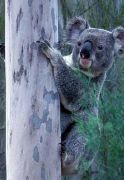 ? How many exist in their natural bushland areas?
? How many exist in their natural bushland areas?
Can you imagine a world without koalas?
Where would Australia be without them and the $2.5 billion a year in tourism they help bring in?
This is the value given by CEO Deborah Tabart of Australian Koala Foundation in a recent article about the unique mapping tool available on the AKF website. Although it's free to access, the information cost $8 million and thousands of volunteer hours to develop. Everyone in the world can now look at over 2000 koala habitat sites where 100,000 trees have been individually measured. Landowners can mark their own koala sightings and developers can see where koalas live. Check out the mapping tool here.
Not all landowners are happy to share their land with koalas - developing for housing or industry.In 1923 it was thought that, from an original population of over 10 million, there were as few as 45,000 koalas left in Australia. Now with 80 per cent of koala habitat cleared for buildings, roads, hard infrastrucure and resource exploration that number is far lower. For a koala, 'no tree' means 'no me'. Read the article here.
Unfortunately the property industry feels no obligation to help protect this unique Australian marsupial - claiming that houses would cost more - obviously passing on all costs to the consumer. Their concerns are reported in this Financial Times article.
The current Senate Inquiry into the status, health and sustainability of Australia's koala population with an interim report tabled 13 May 2011, advising that the committee now intends to table its final report on Wednesday, 24 August 2011.
The submissions received can be read here.
The conservation movement - and LACA Logan and Albert Conservation Association especially - believe the long term survival ie health and sustainability of the koala in Queensland will only be achieved with its being listed as endangered under Australia's EPBC Act.
If you share our concerns, consider writing to your representative as well as Minister Tony Burke who is tasked with the responsibility of making a ruling on the future status of the koala. Current management plans and policies do not protect the koala's habitat and food source. Science is still learning about the ecology and behaviours of the koala but I think there is little doubt that if we clear trees for housing then the koala's survival is limited.
Legislation that has planning power, plus tax or financial incentives to encourage and support private landholders to protect biodiversity are part of the necessary foundation stones, if Australia is going to save the koala on private land. NO TREE NO ME - sums up what we need to do.
Report of the Senate Inquiry into Koalas
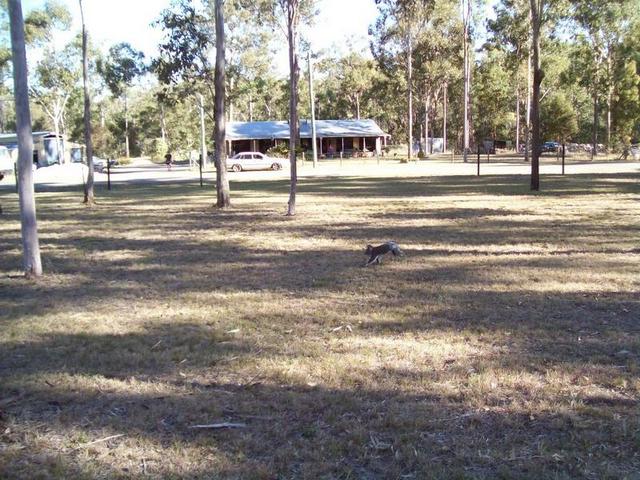 The Report of the Senate Inquiry into Koalas, The koala – saving our national icon, was finally tabled in Federal Parliament on 22 September. It is a very readable document and its nineteen recommendations provide a sound framework for important first steps in improving the chances of saving koalas in areas where their numbers have declined significantly.
The Report of the Senate Inquiry into Koalas, The koala – saving our national icon, was finally tabled in Federal Parliament on 22 September. It is a very readable document and its nineteen recommendations provide a sound framework for important first steps in improving the chances of saving koalas in areas where their numbers have declined significantly.
Minister Burke says he also welcomes the Report and that he will be working through the Committee's recommendations as well as the extensive assessment undertaken by the Threatened Species Scientific Committee and comments from the public in his own assessment of whether or not to list the Koala under the Federal Environment Protection and Biodiversity Conservation Act. While the situation is complex, we believe the Act does lend itself to a vulnerable listing in areas where koala populations have declined significantly or are at risk of doing so.
We call on Minister Burke to find a way to do the right thing and list.
The recommendations can be read here
Of particular importance is Recommendation 17
5.82 The committee recommends the Environment Minister consider options to improve the conservation status of the diverse and rapidly declining koala populations in New South Wales and Queensland to ensure a nationally resilient population is maintained. These options include listing the koala as vulnerable under the EPBC Act in areas where populations have declined significantly or are at risk of doing so.
UNLESS THERE IS FEDERAL LEGISLATION THAT REQUIRES ALL ACTIVITIES WITH POTENTIAL TO IMPACT NEGATIVELY OF THE SURVIVAL OF THE KOALA IN ITS NATURAL HABITAT BE REFERRED FOR FEDERAL JURISDICTION LACA FEARS THAT KOALAS WILL VANISH FROM THE LANDSCAPE OF SOUTH EAST QUEENSLAND.
Current Queensland Policy is smoke and mirrors with most developments ULDA TMR road power water infrastructure being interested only in the lowest cost for their 'job'. Future health and wellbeing of any wildlife is not part of the cost of the activity. There have been no detailed seasonal study for any fauna or flora - apart from Melaleuca Irbyana . Claims are being made that species are locally extinct - at the same time residents are reporting active koala movements.
Image above clearly shows a koala crossing the open land on property behind me. My unmowed native grass paddock would prevent me from seeing a koala crossing. Your sightings are invaluable as data to protect our wildlife.
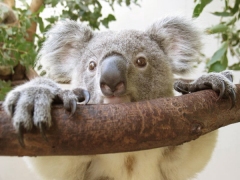
ARE THEY ENDANGERED?
Every day newspapers and websites report information about the increasing threats to the long term survival of our iconic koala. Community and some political concern has persuaded federal government to have an inquiry to determine the status - level of legislated federal protection that is needed to avoid extinction of Australia's much loved koala.
Federal Minister for Environment MP Tony Burke has the responsibility to make that determination. This will not happen until
 Who is wearing blinkers?
Who is wearing blinkers?
Whichever South East Queensland council are you live in there are plans for urban, industry, mining and infrastructure expansion - all meaning loss of bushland vegetated areas. The koala has a very specialised diet - eating only from a range of 17 eucalyptus species. We see huge old gums cut down for a road. Old growth trees and forests are critical not only for koalas but many other species using that habitat. Humans are able to build roads within a short few months or years. We cannot grow forests even in 30 years.
How much does it cost to build a forest? Millions of dollars! This economic cost needs to be added to the cost of the road. Why do we bother with our efforts to replace lost habitat? Do we do it for the animals? In reality governments do it to appease the general community. Perhaps there is a growing realization, that humans also need the forests?
Worldwide there is acceptance that nature has a value - but when those who want to destroy the natural environment are asked to pay compensation then they cry foul!
ELANORA residents' anger over a proposed 15m microwave tower belonging to water retailer Allconnex was provoked further yesterday when tree-loppers cut down two mature trees and only spared a third giant gum after they began filming and journalists arrived on the scene http://www.goldcoast.com.au/article/2011/06/04/320871_gold-coast-news.html
KOALA data collection in Logan - can you help?
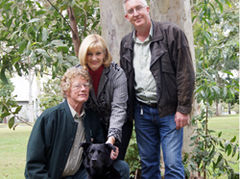 The announcement by Logan City Council that it will ask residents to collect information regarding the sex, health, location, behaviour and the tree species in which koalas are located is welcome. There is an acknowledgement that koalas are an important part of our environment.
The announcement by Logan City Council that it will ask residents to collect information regarding the sex, health, location, behaviour and the tree species in which koalas are located is welcome. There is an acknowledgement that koalas are an important part of our environment.
We are particularly keen to understand how Logan City Council's koala dog Oscar - pictured aside will complement the koala survey methods used by volunteer resident "citizen scientists" to provide more accurate local habitat mapping city wide.
Although curently Logan may be blessed by 78.9% tree cover that is subject to rapid clearing of sustantial areas for new housing developments, industrial development and the crisscrossing of roads creating a patchwork of disconnected areas of habitat which make no provisions for safe movement of any of our local fauna.
Read council's news re the koala dog here.
As yet there is no online process to become involved in the survey. Read about it here. Phone 3412 3412 for more information.
It is useful to understand that koalas' food source tree the eucalypt is eaten very selectively - only 17 out of 700 different gums are favoured locally growing gums - and then there are other factors not yet understood. In order for all plants to reproduce pollination has to occur and the pollinator of eucalypts is the flying fox.
Our much loved koala and the targeted maligned and misunderstood flying fox are co dependant - both needing the eucalypt as a food source. The flowers of gums open at night when flying foxes are foraging and are thus pollinated by these critically important animals. The collapse of honey bees worried our food production because the uncosted labour performed by bees is difficult to replicate by humans [ not impossible in some circumstances.
How would we scale trees at night in a 4 hour window of time to replace the pollination services of flying foxes? All too often we fail to see wider connections of ecosystem and ecological services - provided freely when biodiversity infrastructure is intact - by our ecosystem services.
 The Department of Environment and Resource Management (DERM) has invested resources in the management and delivery of wildlife and inventory information to its internal and external clients. The Environmental Information Systems Unit is the custodian of the WildNet and Wetland Information Capture System (WIC) applications and works with DERM and external partners for the acquisition and delivery of a range of wildlife and survey information.
The Department of Environment and Resource Management (DERM) has invested resources in the management and delivery of wildlife and inventory information to its internal and external clients. The Environmental Information Systems Unit is the custodian of the WildNet and Wetland Information Capture System (WIC) applications and works with DERM and external partners for the acquisition and delivery of a range of wildlife and survey information.
The reporting of wildlife - both dead and alive - to DERM IS A CRITICAL ACTION for all citizens to do.
WHY is reporting of wildlife SO IMPORTANT?
Sightings are entered into a data base and are used in DESKTOP STUDIES by consultants researchers and others to help compile environmental assessments that are part of development applications.Sometimes the citizen scientists' wildlife sightings may be the only record.
Wildlife Online allows internet users to request species lists for selected areas, specified points or defined areas. The options include species (all, plant or animal), type (all, native or introduced), status (all or rare and threatened), records (all, confirmed or specimen), date (all or since 1980) and output (pdf or text file).
Species lists for protected areas (national parks, conservation parks and resources reserves), forestry areas (State forests and timber reserves) and Local Government Areas in
Users can also request species lists generated from summarised sighting data for buffered points or defined areas using coordinates (decimal degrees). The submitted requests are processed every 15 minutes and the resultant species lists are sent to the user’s email account as an attachment. The species outputs includes kingdom, class, family, scientific name, common name, introduced flag, NCA status, EPBC Act status, number of records and number of specimens.
For more information about
LACA Logan and Albert Conservation Association strongly urges all new residents in any area to find out what wildlife has been recorded in the area and also to continue to update the online database. This list can also be useful to help you identify a spcies you see in your area. The information has been adapted from a document DERM sent to us. This is that document. DERM_Internet_Wildlife_Information_Systems012011.doc 113.50 Kb 18/02/2011, 17:34
DERM_Internet_Wildlife_Information_Systems012011.doc 113.50 Kb 18/02/2011, 17:34
LACA also has an online form you can fill in which we forward to DERM. Locate this in lefthand column front page. While sightings of koalas are critical because there are some planning regulations that may help - though they are still inadequate - all species are important.
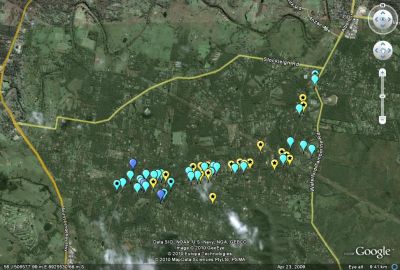 This image of glider sightings has been compiled from sightings reported from residents along Camp Cable Waterford Tamborine Road and Hotz Road as part of the VETO survey from March to June 2010.
This image of glider sightings has been compiled from sightings reported from residents along Camp Cable Waterford Tamborine Road and Hotz Road as part of the VETO survey from March to June 2010.
The blue marker represents feather tail glider sightings. The aqua marker represents sugar glider, squirrel glider or general glider sightings.
The aqua marker with the star represent the greater glider sightings. The yellow markers represent residents who reported wildlife sightings but did not report glider sightings. There was a total of 50 residents (mostly directly affected and some indirectly affected) so far who have reported these results to VETO.
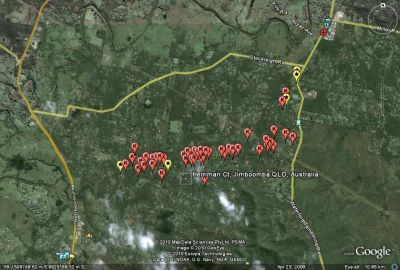
This image with the VETO willdlife sightings from the surveys conducted from March to June 2010. Some are current sightings and some are historic sightings. There are a total of 50 residents surveyed so far (mostly directly affected and some non directly affected) . The red markers represent koala sightings reported by residents . The yellow markers represent residents who did not report seeing or hearing koalas on their property.
The use of digital tools available for us all now - as and when we learn how to use these webtools - are an essential piece of out activist - advocacy toolkit. Photos maps aerial images from Google Earth or NearMap can help us support our efforts to secure ecologically sustainable development.
Business as usual is not acceptable for us now, our children and future children.
 DID YOU HEAR THAT KOALA LAST NIGHT?
DID YOU HEAR THAT KOALA LAST NIGHT?
A long term resident of Greenbank last night reported hearing the unmistakable calls / grunts of koalas in trees on his property. This information was relayed to me less than 40 minutes after the noisy koala. Evidence available to us that koalas are NOT locally extinct in Greenbank . We were both attending the SAVE GREENBANK CAMPAIGN meeting 23 February2011
If we can prove that our resident Greenbank Jimboomba Flagstone koalas are alive and well we will have a greater chance of delaying inappropriate development.
Many of us have resident koalas that we see but do not report. Please report your sightings to LACA president Anne Page mkpage@bigpond. We have arranged to have our wildlife sightings accepted by DERM and ULDA.
SPOTTED TAILED QUOLL have also been seen in the area. We need to update that data also. GLOSSY BLACK COCKATOOS are another significat species. While all species are important to the survival of the habitat humans also need to have a healthy lifestyle, the more iconic species named carry greater levels of protection.
LACA submission to the Senate Inquiry for koalas
Inquiry into the status, health and sustainability of Australia's koala population
 sub49_SENATE_koala_inquiry2011.pdf 02/03/2011, 14:39
sub49_SENATE_koala_inquiry2011.pdf 02/03/2011, 14:39  KOALAS - will they survive in Greater Flagstone UDA?
KOALAS - will they survive in Greater Flagstone UDA?
The koala was nominated for listing as a threatened species under national environment law—the Environment Protection and Biodiversity Conservation Act 1999—and was assessed by the Threatened Species Scientific Committee (TSSC) during 2008-2010. The TSSC recommended that the koala was not eligible for listing as nationally threatened, but noted that reaching a conclusion was challenging due to significant gaps in national koala population data.
The Minister has extended the decision timeframe on the listing of the koala as a threatened species, so that he can consider the Senate inquiry's findings before making his decision. You can follow that process here.
Detailed state or local government funded koala surveys have not been conducted in the areas proposed for UDA although DERM mapping indicates that essential koala habitat exists.
Wildlife Queensland Bayside branch have provided us with a copy their submission as it relates to koalas. The long term survival of our national iconic species is of national significance. Read WPSQ Bayside branch submission here  submission-to-greater-flagstone-uda-01-koalas.pdf
submission-to-greater-flagstone-uda-01-koalas.pdf
While conservation groups like LACA advocate for the koala as a unique species within the local and regional biodiversity, other organizations such as the Urban Development Institute of Australia UDIA told the Senate inquiry that further protection of koalas was premature and would cost much-needed jobs.
Battle of the bulldozer versus a national icon as reported in the Courier Mail here. Koala conservation is an imperative of more than just biological and cultural concern, it is an issue of national identity, international image and reputation. LACA supports the view of the UQ Koala Ecology Group which said listing koalas as endangered would at least provide a "speed bump in the road to extinction".
IF YOU SEE A KOALA PLEASE REPORT YOUR SIGHTINGS TO DERMs WILDNET.
IF YOU NEED HELP WITH THIS CONTACT LACA president Anne Page on 3297 0624 .
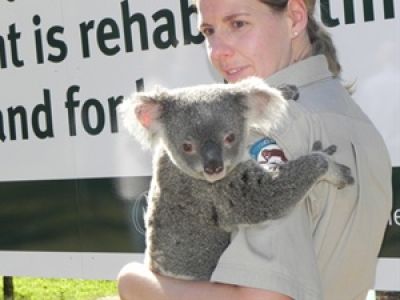 LOCAL councils have been given ultimate control over development proposed for koala habitat and charged with increasing habitat areas by 2020 under new State Government laws announced in the Redlands on Saturday. Sustainability Minister Kate Jones and Planning Minister Stirling Hinchliffe visited a koala revegetation site in Capalaba West to announce the two new pieces of legislation, which will dictate how developers and councils use land in order to increase koala habitat substantially by 2020.
LOCAL councils have been given ultimate control over development proposed for koala habitat and charged with increasing habitat areas by 2020 under new State Government laws announced in the Redlands on Saturday. Sustainability Minister Kate Jones and Planning Minister Stirling Hinchliffe visited a koala revegetation site in Capalaba West to announce the two new pieces of legislation, which will dictate how developers and councils use land in order to increase koala habitat substantially by 2020.
"The new laws will deal with irresponsible planning which has occurred in some places in the past and override existing planning schemes so that koala habitat must be taken into account," Ms Jones said.
"Councils gave us overwhelming feedback that they were best placed to tailor localised solutions," Mr Hinchliffe said. "The main objective is that planning schemes must incorporate provisions to ensure development in koala areas delivers a net increase in koala habitat by 2020," he added. The new State Planning Regulatory Provisions (SPRP) place strict limits on developers, including banning clearing of mapped koala habitat, offset planting for unavoidable clearing of koala trees at a ratio of five trees planted for every one cleared, and requirements for koala sensitive urban design.
The new State Planning Policy (SPP) will see councils amend their planning schemes to identify and protect koala habitat while retaining and enhancing habitat connectivity with koala corridors. Councils will also have to increase the amount of bushland habitat, ensure koala movement-friendly design and layout for developments and develop a koala conservation strategy, which will be reviewed by the state to show how outcomes are being met.
KOALA SIGHTINGS (Browns Plains to Veresdale Scrub, Yatala to Ipswich City)
T he koala sightings in the map shown (click to enlarge) have been reported to WILDNET (Department of Environment and Resource Management) by the community and other scientific experts, and are current to June 2009 and include historically observations as well. The koala population in the Mount Lindesay North Beaudesert area have NEVER been properly surveyed by any local council or by state government and these WILDNET sightings provide very valuable information for the local area when no other detailed studies have been undertaken.
he koala sightings in the map shown (click to enlarge) have been reported to WILDNET (Department of Environment and Resource Management) by the community and other scientific experts, and are current to June 2009 and include historically observations as well. The koala population in the Mount Lindesay North Beaudesert area have NEVER been properly surveyed by any local council or by state government and these WILDNET sightings provide very valuable information for the local area when no other detailed studies have been undertaken.
LACA encourages the community to continue to report their valuable wildlife sightings from their local area or from other areas the community may visit.
PROPOSED ENERGEX POWERLINE ROUTE - CAMP CABLE RD / WATERFORD-TAMBORINE RD /
LOGAN RIVER / LOGAN RESERVE RD and KOALAS
This WILDNET map reveals that there are numerous sightings of koalas to the north and south of Camp Cable Rd and east and west of Waterford -Tamborine Rd. RSPCA and residents have reported collecting dead and injured koalas from the vicinity of the new Camp Cable Rd and surrounding areas. There are already existing cleared easements for Powerlink easements ( north of Camp Cable Rd) and Energex easements (south of Camp Cable Rd) that create barriers for koala movement and increase the length of time that koalas may spend moving over open ground and therefore place koalas at greater risk of cars and dog attack. Local residents along Camp Cable Rd have already noted a decline in visits by native animals as a result of the construction of the new alignment for Camp Cable Rd a few years ago. Energex's own IAR report from June 2009 acknowledges that current powerline easements already fragment habitat and this proposed route will continue to fragment and degrade the habitat further with further negative impacts on local and regional significant fauna species such as koalas.
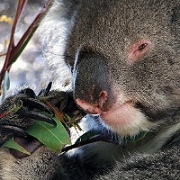 Modern koalas - the sole living member of the diprotodontian marsupial family Phascolarctidae - are among the largest of all arboreal leaf-eaters. To attain this remarkable condition on a diet of eucalyptus leaves, a notoriously poor and somewhat toxic food source, the tree-dwelling marsupials developed unique anatomical and physiological adaptations including specialized chewing and digestive anatomies and a highly sedentary lifestyle. The dramatic differences between the skulls of extinct and modern koalas, especially in the facial region, are probably related to the change to a tougher diet of eucalyptus leaves.
Modern koalas - the sole living member of the diprotodontian marsupial family Phascolarctidae - are among the largest of all arboreal leaf-eaters. To attain this remarkable condition on a diet of eucalyptus leaves, a notoriously poor and somewhat toxic food source, the tree-dwelling marsupials developed unique anatomical and physiological adaptations including specialized chewing and digestive anatomies and a highly sedentary lifestyle. The dramatic differences between the skulls of extinct and modern koalas, especially in the facial region, are probably related to the change to a tougher diet of eucalyptus leaves.
This research has recently been reported at www.physorg.com - from the new findings published as the featured cover article in the current issue of The Journal of Vertebrate Paleontology.
Skull fragments of prehistoric koalas from the Riversleigh rainforests of millions of year ago suggest they shared the modern koala's "lazy" lifestyle and ability to produce loud "bellowing" calls to attract mates and provide warnings about predators but did not share the uniquely specialized eucalyptus leaf diet of the modern koala (Phascolarctos cinereus).
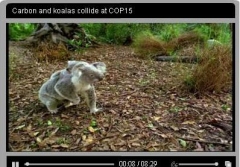 At Copenhagen, the Australian Koala Foundation (AFK) argues two things:
At Copenhagen, the Australian Koala Foundation (AFK) argues two things:
1. Protecting the koala forests of Australia is an imperative step towards reducing greenhouse emissions in Australia and,
2. AKF science shows it will be impossible to replace the carbon in those forests if they are destroyed.
You can watch the video footage at www.climatetalks.tv.
This link will take you the page with free material to broadcast and online news usage.
From Deborah's diary...
When I return to Australia I want to speak with my Board because I believe even though we know the koala forests are filled with carbon, what must never be lost is just the fundamental respect we have to have for the forests of the world. I believe this is what HRH Prince Charles will be speaking about tomorrow and I must never forget this.
I spoke with one of the Non Governmental Organisation (NGO) negotiators, and she told me that mostly the delegates writing the legislation for REDD are bureacrats from countries all over the world - many of whom have never seen a koala, a forest or any sort of animal. They have been 'educated' by these hardworking NGO's that I have come to respect very much, but they tend to focus on the 'additionality' or 'co-benefits', which means that there might be an animal in there, or some benefit to a local tribe (the lack of respect for the indigenous people of the world just keeps coming through time and time again), but of course all of this still does not apply to Australia. They remind me of the paper shufflers I have met in every Government Department in Australia. Remind me to tell you about the latest letter I received from the Queensland Government by the way.
The whole process is soul-less. It concerns me greatly. I believe it could be so much simpler:
1. Map what we have.
2. Protect the biodiversity that is fundamental to us as a planet.
3. Protect the rivers so we have clean water.
4. Clean up the mess we have created.
5. Plant more trees
6. Grow more vegetables.
7. Provide a future for our children.
I honestly haven't seen anything as simple as this, except from the indigenous people who are here and, like the koala, don't seem to be heard.
The State Government is backing away from an error that mapped the Coomera Town Centre precinct as both pro-development and pristine koala habitat. Infrastructure and Planning Minister Stirling Hinchliffe will today announce the Government will hold off on new koala protection regulations until next year.
The decision follows a furore from the Gold Coast City Council and the development industry over contradictory maps which could have derailed 15 years of state and council planning for the Coomera Town Centre precinct.
The biggest concern was a triangle-shaped patch of zero-development koala protection area that was mapped directly over the central heart of the town centre. Mr.Hinchliffe said uproar from the council and surrounding local governments warranted the extension.
"While protecting koalas is an urgent priority, the State Government is committed to carrying out comprehensive consultation to ensure the regulations are effective" he said.
Coomera councillor Donna Gates said the decision was good news for the council and the Coomera Town Centre. It's very positive that they listened and have allowed additional time to clarify which of their policies will take precedence in Coomera", she said.
Dr Baxter (Senior Lecturer in Natural Systems Management at University of Queensland)says that the 2006 Koala Plan released by former Environment Minister Desley Boyle [ a four-year, $A2.1 million dollar Koala Plan that was implemented in October 2006] does not address the fundamental problems the koala is facing, which is the fragmentation or loss of their habitat.
Koalas need large areas of healthy, safe and connected bushland in order to survive and this is under threat from development, logging and agriculture all over South East Queensland. At the beginning of last century there were millions of koalas in the wild. Now there is only a fraction of that number left in Queensland, estimated (in 2006) to be between 100,000 and 300,000 and rapidly declining. For the koala, more than 80 per cent of their home ranges have been destroyed and this is still increasing - despite our knowledge of their need for essential habitat to survive.
It is not rocket science. Humans also need trees to provide essential ecosystem services for our health and wellbeing of the whole planet. The koalas diet is very specialised and evolved to adapt to the eucalypt tree as a food source - but not every eucalypt tree is acceptable for all koalas. Essential bushland habitat can not be offset by some quickly planted trees.
This letter  DIP_UDIA_Letter.pdf 643.39 Kb 15/12/2009, 13:12 assures developers that the new koala State Planning Policy SPP will not create greater costs to development. Unfortunately from a reading of the carefully worded rhetoric of the letter sent to the Urban development institute of Australia, the profits of developers is more important than survival of our iconic species the koala.
DIP_UDIA_Letter.pdf 643.39 Kb 15/12/2009, 13:12 assures developers that the new koala State Planning Policy SPP will not create greater costs to development. Unfortunately from a reading of the carefully worded rhetoric of the letter sent to the Urban development institute of Australia, the profits of developers is more important than survival of our iconic species the koala.
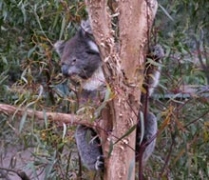 IMPLEMENTATION OF NEW KOALA PLANNING INSTRUMENTS DEFERRED
IMPLEMENTATION OF NEW KOALA PLANNING INSTRUMENTS DEFERRED
Australian Koala Foundation said recently that Queensland government's new planning laws to protect dwindling koala numbers in the state's southeast are laughable. Although Climate Change and Sustainability Minister Kate Jones announced a raft of new measures to protect the marsupials' habitats - what is proposed is not enough. For years concerned citizens campaigning to raise awareness of the plight of the koala and protect them by protecting and preserving the essential habitat with an easy to remember slogan - NO TREE NO ME.
MAPPING has placed a triangle-shaped patch of zero-development koala protection area directly over that same patch developers have planned as the central heart of the town centre.
Further to a letter from the Director-General which was circulated to members (of UDIA Qld) on Wednesday, the Government has now deferred the implementation of koala planning controls to replace the interim controls until 28 February 2010 and they will not come into effect as at 1st January as previously proposed. Further opportunity for consultation on proposed changes and a draft State Planning Policy is being provided. The UDIA (Qld) is engaging with the Government and a forum will be held in the new year to discuss practical implementation issues associated with the draft instruments.
Gold Coast Bulletin, Friday 11 December 2009, page 3 "States koala chaos on map"